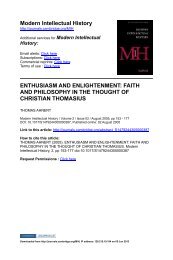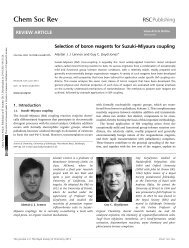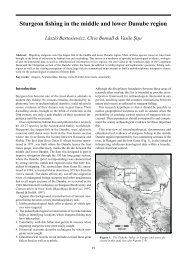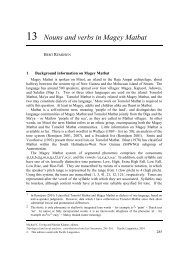Retistruct: Reconstruction of Flat-mount <strong>Retina</strong>erelaxing cuts, toge<strong>the</strong>r with tears that can occur during flattening,disturbs <strong>the</strong> retinal geometry significantly, which not onlycomplicates comparison across retinae, but also can be problematicin interpreting results obtained from individual flat-mountedretinae. For example, various measures are used to quantify <strong>the</strong>regularity of mosaics of various cell types seen in flat-mountedretinae [11,12], but <strong>the</strong>se are susceptible to <strong>the</strong> existence ofboundaries [13], both at <strong>the</strong> rim of <strong>the</strong> retina <strong>and</strong> those introducedby <strong>the</strong> relaxing cuts. In <strong>the</strong> study of topographic mapping, <strong>the</strong>locations of ganglion cells labelled by retrograde tracers injectedinto different locations in <strong>the</strong> target, <strong>the</strong> superior colliculus, havebeen compared in retinal flat-mounts [4,5]. Foci of labelled cellscan be separated, or even split, by relaxing cuts (see Figure 1A),complicating quantitative analyses.We describe a method to infer where points on a flat-mountretina would lie in a st<strong>and</strong>ard, intact retinal space. The st<strong>and</strong>ardretina is approximated as a partial sphere, with positions identifiedusing spherical coordinates. Our results show that <strong>the</strong> method canestimate <strong>the</strong> location of a point on a flat-mounted retina to within8u of arc of its original location, or 3.6% of <strong>the</strong> NT or DV axis.This has allowed us to define a st<strong>and</strong>ard retinal space <strong>for</strong> <strong>the</strong> adult<strong>and</strong> <strong>for</strong> <strong>the</strong> developing mouse eye. Establishing <strong>the</strong> orientation ofretinal space <strong>for</strong> <strong>the</strong> mouse, whose retina contains no intrinsicmarkers, requires experimental intervention. In <strong>the</strong> Results, wefocus on data from adult mice. We show that a mark based on <strong>the</strong>centre of <strong>the</strong> nictitating membrane is reliable <strong>and</strong> this mark can berelated to <strong>the</strong> insertion of <strong>the</strong> rectus eye muscles. Fur<strong>the</strong>rmore, wetrans<strong>for</strong>m st<strong>and</strong>ard retinal space into visuotopic space <strong>and</strong> use <strong>the</strong>geometry of binocular vision, toge<strong>the</strong>r with anatomical tracing, toaddress questions about <strong>the</strong> projection of <strong>the</strong> optical axis of <strong>the</strong>mouse eye into visual space [3,14,15].Our Retistruct algorithm not only facilitates comparison ofdifferential retinal distributions across animals but also allowsanalyses of distributions of labelled cells in spherical coordinates,obviating <strong>the</strong> distortions associated with 2D flat-mounts. Finally,trans<strong>for</strong>ming retinal coordinates into visual coordinates givesinsights into <strong>the</strong> functional significance of retinal distributions.Design <strong>and</strong> ImplementationThe reconstruction algorithmIn this section we give an overview of <strong>the</strong> reconstructionalgorithm; a more detailed description is contained in <strong>the</strong>Supplemental Materials <strong>and</strong> Methods (Text S1). The startingpoint of <strong>the</strong> algorithm is <strong>the</strong> flattened retinal outline (Figure 1A),which can include an image or labelled features. In Figure 1A <strong>the</strong>outline includes a l<strong>and</strong>mark (blue line), in this case <strong>the</strong> optic disc,<strong>and</strong> <strong>the</strong> locations of retinal ganglion cells that have beenretrogradely labelled following discrete injections of red <strong>and</strong> greenfluorescent tracers into a retino-recipient central nucleus (<strong>the</strong>superior colliculus). One of <strong>the</strong> relaxing cuts has bisected <strong>the</strong>labelled foci – principally <strong>the</strong> red one. The first step is to mark <strong>the</strong>nasal retinal pole (in Figure 1B, ‘‘N’’), which is defined by <strong>the</strong>perimeter of <strong>the</strong> long cut towards <strong>the</strong> optic disc from <strong>the</strong>peripheral fiducial mark based on <strong>the</strong> nictitating membrane (seeMaterials <strong>and</strong> Methods). The locations <strong>and</strong> extents of cuts <strong>and</strong>tears in <strong>the</strong> outline are also marked up (cuts 1–4 in Figure 1B).Because <strong>the</strong> retina in <strong>the</strong> eye-cup is more than hemispherical, <strong>the</strong>angle of <strong>the</strong> retinal margin (rim angle) measured from <strong>the</strong> pole of<strong>the</strong> retina is <strong>the</strong>n supplied (Table 1 <strong>and</strong> see later section below).The outline is <strong>the</strong>n divided into a mesh containing at least 500triangles of roughly equal size, <strong>and</strong> <strong>the</strong> cuts <strong>and</strong> tears are stitchedtoge<strong>the</strong>r (Figure 1C). This mesh is <strong>the</strong>n projected onto a sphericalsurface, with all <strong>the</strong> points on <strong>the</strong> retinal margin lying on <strong>the</strong> circledefined by <strong>the</strong> rim angle (Figure 1Di). Each edge in <strong>the</strong> mesh istreated as a spring whose natural length is <strong>the</strong> length of <strong>the</strong>corresponding edge in <strong>the</strong> flat mesh. It is not possible to make thisinitial mapping onto <strong>the</strong> spherical surface optimal, so <strong>the</strong> springsare ei<strong>the</strong>r compressed (blue), exp<strong>and</strong>ed (red) or retain <strong>the</strong>ir naturallength (green). In <strong>the</strong> next step <strong>the</strong> springs are allowed to relax soas to minimise <strong>the</strong> total potential energy contained in all <strong>the</strong>springs, leading to <strong>the</strong> refined spherical mesh shown in Figure 1Ei.The locations of mesh points in <strong>the</strong> flat-mount <strong>and</strong> <strong>the</strong>ircorresponding locations on <strong>the</strong> sphere define <strong>the</strong> relation betweenany point in <strong>the</strong> flat-mount <strong>and</strong> a st<strong>and</strong>ard spherical space. Thisrelation is used to map <strong>the</strong> locations of data points <strong>and</strong> l<strong>and</strong>marksin <strong>the</strong> flat retina onto <strong>the</strong> st<strong>and</strong>ard retina. These can be visualisedinteractively on a 3D rendering of a sphere (see Figure 1D), orrepresented using a map projection such as <strong>the</strong> azimuthalequidistant projection centred on <strong>the</strong> retinal pole (Figure 1Fi). Inall plots of retinal space we use <strong>the</strong> colatitude <strong>and</strong> longitudecoordinate system, where colatitude is like latitude measured on<strong>the</strong> globe, except that zero is <strong>the</strong> pole ra<strong>the</strong>r than <strong>the</strong> equator.Map projections [16] such as that in Figure 1Fi are very useful <strong>for</strong>rendering retinal label into a st<strong>and</strong>ard retinal space. An alternativerepresentation is shown in Figure 1Dii,Eii,Fii, where lines oflatitude <strong>and</strong> longitude on <strong>the</strong> st<strong>and</strong>ard spherical retina have beenprojected onto <strong>the</strong> flat structure. The jump between Figure 1Dii<strong>and</strong> 1Eii illustrates <strong>the</strong> improvement in <strong>the</strong> appearance of <strong>the</strong>mapping achieved after minimising <strong>the</strong> energy.In order to analyse data points on <strong>the</strong> st<strong>and</strong>ard retina, we usedspherical statistics [17]. The mean locations of groups of datapoints on <strong>the</strong> sphere (diamonds in Figure 1Fi) are computed using<strong>the</strong> Karcher mean <strong>and</strong> we used density estimation to producecontour plots (see Supplemental Materials <strong>and</strong> Methods, Text S1).Per<strong>for</strong>mance of <strong>the</strong> algorithmTo assess <strong>the</strong> amount of residual de<strong>for</strong>mation at <strong>the</strong> end of <strong>the</strong>energy minimisation procedure, we plotted <strong>the</strong> length of each edgei in <strong>the</strong> spherical mesh l i versus <strong>the</strong> length of <strong>the</strong> correspondingedge in <strong>the</strong> flat mesh L i (Figure 2A), using <strong>the</strong> same colour scale asin Figure 1D,E. A measure of <strong>the</strong> overall de<strong>for</strong>mation ofreconstruction is:vffiffiffiffiffiffiffiffiffiffiffiffiffiffiffiffiffiffiffiffiffiffiffiffiffiffiffiffiffiffiffiffiffiffiffiffiu 1 X (l i {L i ) 2e L ~ t2DCDLwhere <strong>the</strong> summation is over C, <strong>the</strong> set of edges, <strong>the</strong> mean lengthof an edge in <strong>the</strong> flat mesh is L, <strong>and</strong> <strong>the</strong> number of edges is DCD.Physically, this measure is <strong>the</strong> square root of <strong>the</strong> elastic energycontained in <strong>the</strong> notional springs. It is constructed so as to be of asimilar order to <strong>the</strong> mean fractional de<strong>for</strong>mation.We used our algorithm on 297 flat-mounted retinae, 288 ofwhich could be reconstructed successfully, 7 of which failed due to,as-yet unresolved, software problems <strong>and</strong> 2 of which were rejectedbecause of unsatisfactory reconstructions (see below). Figure 2Ashows <strong>the</strong> reconstruction with <strong>the</strong> lowest de<strong>for</strong>mation measuree L ~0:038 <strong>and</strong> Figure 2E <strong>the</strong> example with a high value ofe L ~0:118. The arrangement of <strong>the</strong> grid lines in <strong>the</strong> example withlower de<strong>for</strong>mation looks qualitatively smoo<strong>the</strong>r <strong>and</strong> more eventhan in <strong>the</strong> example with higher de<strong>for</strong>mation measure(Figure 2C,G). The strain plot <strong>for</strong> <strong>the</strong> retina with <strong>the</strong> lowerde<strong>for</strong>mation (Figure 2B) indicates that almost all edges areunstressed, whereas in <strong>the</strong> retina with higher de<strong>for</strong>mation(Figure 2F) <strong>the</strong>re are many more compressed <strong>and</strong> exp<strong>and</strong>ededges. It can be seen that <strong>the</strong> retina in Figure 2E–H has a muchi[CL ið1ÞPLOS Computational Biology | www.ploscompbiol.org 2 February 2013 | Volume 9 | Issue 2 | e1002921
Retistruct: Reconstruction of Flat-mount <strong>Retina</strong>eFigure 1. Overview of <strong>the</strong> method. A, The raw data: a retinal outline from an adult mouse (black), two types of data points (red <strong>and</strong> green circles)from paired injections into <strong>the</strong> superior colliculus <strong>and</strong> a l<strong>and</strong>mark (blue line). B, <strong>Retina</strong>l outline with nasal pole (N) <strong>and</strong> cuts marked up. Each pair ofdark cyan lines connects <strong>the</strong> vertices <strong>and</strong> apex of <strong>the</strong> four cuts. C, The outline after triangulation (shown by grey lines) <strong>and</strong> stitching, indicated bycyan lines between corresponding points on <strong>the</strong> cuts. Di, The initial projection of <strong>the</strong> triangulated <strong>and</strong> stitched outline onto a curtailed sphere. Thestrain of each edge is represented on a colour scale with blue indicating compression <strong>and</strong> red expansion. Cuts are shown in cyan. Dii, The strainplotted on <strong>the</strong> flat outline with lines of latitude <strong>and</strong> longitude superposed. Ei,ii, As Di,ii but after optimisation of <strong>the</strong> mapping. Fi, The datarepresented on a polar plot of <strong>the</strong> reconstructed retina. Mean locations of <strong>the</strong> different types of data points are indicated by diamonds. The nasal (N),dorsal (D), temporal (T) <strong>and</strong> ventral (V) poles are indicated. Cuts are shown in cyan. Fii, Data plotted on <strong>the</strong> flat representation, with lines of latitude<strong>and</strong> longitude superposed. All scale bars are 1 mm.doi:10.1371/journal.pcbi.1002921.g001less distinct margin than in Figure 2A–D. This makes it harder <strong>for</strong><strong>the</strong> algorithm to create an even mapping, as local roughness in <strong>the</strong>rim <strong>for</strong>ces significant de<strong>for</strong>mation of <strong>the</strong> surrounding virtual tissuewhen morphed onto <strong>the</strong> sphere.Thus <strong>the</strong> de<strong>for</strong>mation measure e L gives some indication of <strong>the</strong>apparent quality of <strong>the</strong> reconstruction. A value greater than 0.2indicates a problem with <strong>the</strong> stitching part of <strong>the</strong> algorithm; <strong>the</strong> 2such reconstructions were rejected <strong>and</strong> are not included in <strong>the</strong> 288PLOS Computational Biology | www.ploscompbiol.org 3 February 2013 | Volume 9 | Issue 2 | e1002921









